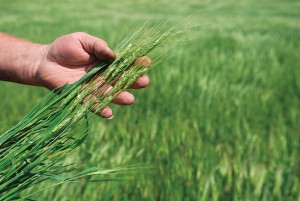Nitrogen fertilization of wheat is more complicated and the results are more variable than with any other field crop grown in Kentucky. A producer must incorporate the practices that will give him the best chance of success with the yield levels he is trying to achieve. The higher the yield goal the more important the nitrogen management becomes. In many cases, timing is as important as the amount of nitrogen applied.
Fall Nitrogen
Wheat only needs a small, but important amount of nitrogen in the fall. This requirement can be met with the residual nitrogen in the soil following a soybean crop, a well fertilized corn crop, or with an application of 20-40 lb/ac of actual nitrogen. Fall nitrogen fertilization becomes more important with late plantings (after the first week of November) and light stands (less than 25 plants/sq. ft.).
Research indicates that nitrogen added in the fall on a light stand of wheat can many times substitute for a late winter (early Feb.) application for stimulating increased tillering. Due to Kentucky’s wet winters, very little of the nitrogen applied in the fall should be accredited towards the total amount of nitrogen needed by the crop.
Late Winter (Early Feb.)
If nitrogen is applied at this stage it should be only in the 30 to 50 lb/ac range with another and larger application in March. Nitrogen applied at this time is most beneficial on fields which need more tillering due to thin stands or lack of fall tillering. Excessive nitrogen applied at this stage can increase chances of diseases and damage from late spring freezes. Also, it is more likely to be lost due to leaching before the crop can take it up.
Spring (March)
The nitrogen applied at this stage is by far the most effective. The best time is about mid-March just before the wheat starts growing rapidly. Applications earlier than this increase the chances of loss during rainy periods. The amount of nitrogen used during this time should be enough to bring the total amount of nitrogen used in February and March to the 60-90 lb/ac range. Yields goals of over 50 bu/ac should have a total of 80-90 lb/ac of N. Some programs successfully recommend a total of 100 to 110 lb/ac of N when the yield goal is for maximum yields and there is a February and March application, but these higher N rates increase the chances of lodging and diseases. No-till wheat requires about 30 lb/ac more nitrogen than conventionally planted wheat because nitrogen is less efficient with this system.
Split Applications
When comparing the single March application against the February and March split application at the same rates, research indicates 1) yields are increased an average of about 3 bu/ac with the split, but it varies from year to year, 2) splitting reduces lodging potential because the February application encourages a larger plant early, and 3) splitting increases the chance of damage from a late spring freeze.
Distribution
Since the window between enough and too much nitrogen is small, distribution in the field is important. The best distribution can be achieved with liquid nitrogen or airflow delivery trucks for solid nitrogen forms. If a spinner system is used, distribution can be improved by cutting the spreading distance in half (example, cut the rate in half and drive on 30 ft. centers instead of 60 ft. centers).
Nitrogen Sources
If evenly distributed, all nitrogen sources perform equally at this time of the year. Leaf burn can be a concern with liquid nitrogen. This can be reduced or eliminated by 1) streaming the liquid N, 2) using flood nozzles, 3) mixing 1/2 water, 4) applying less than 60 lb/ac of N per application, or 5) avoid applications on cold, windy days. Although the burning of wheat with liquid N looks bad, there is little research evidence to indicate that it actually reduces yields.
Timing
Remember, that the time of N applications can be as important as the amount used, whether it be a spring split application or a single spring application.
This article is brought to you by the University of Kentucky, written by Extension Soils Specialist Lloyd Murdock

